Tuesday, May 23, 2023: In the footsteps of my father.
Info:
With about 8,900 inhabitants Kapuskasing is a growing town with 65 % of the population speaking French as their mother-tongue.
Originally it was founded as a camp during the construction of the Transcontinental Railway. In 1917 it was named Kapuskasing, a word of Cree origin meaning “bend in the river”. The Kapuskasing River actually takes a sharp turn there.
The foundation of the papermill in 1920 contributed to the development of the town. Many people got jobs in the company or in the logging camps in the forests, in order to produce paper for the New York Tribune.
James Cameron was born in Kapuskasing.
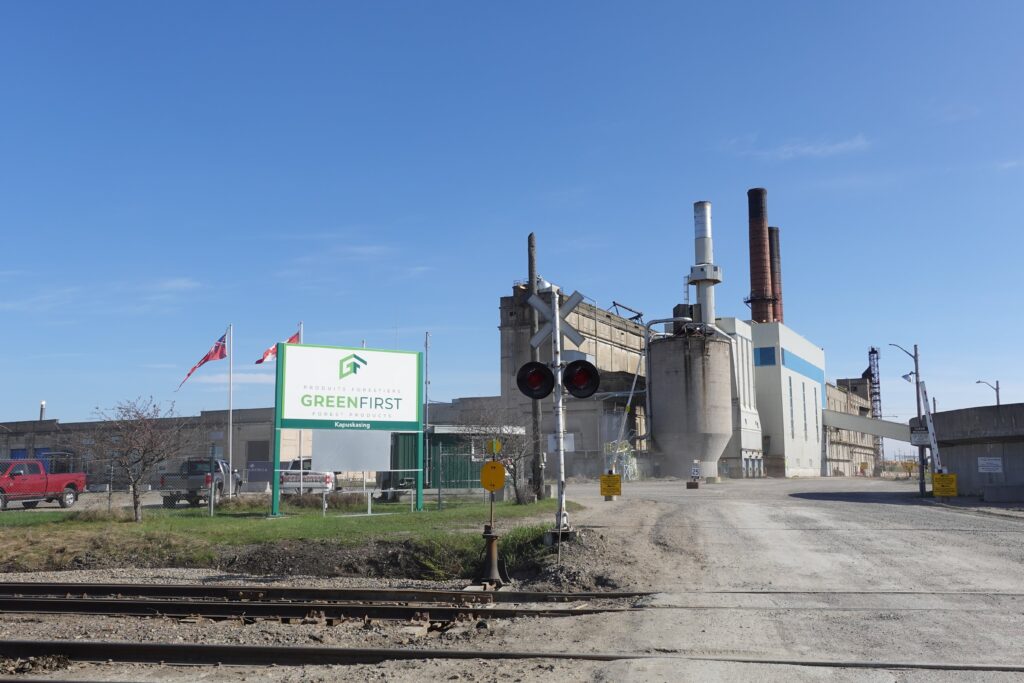
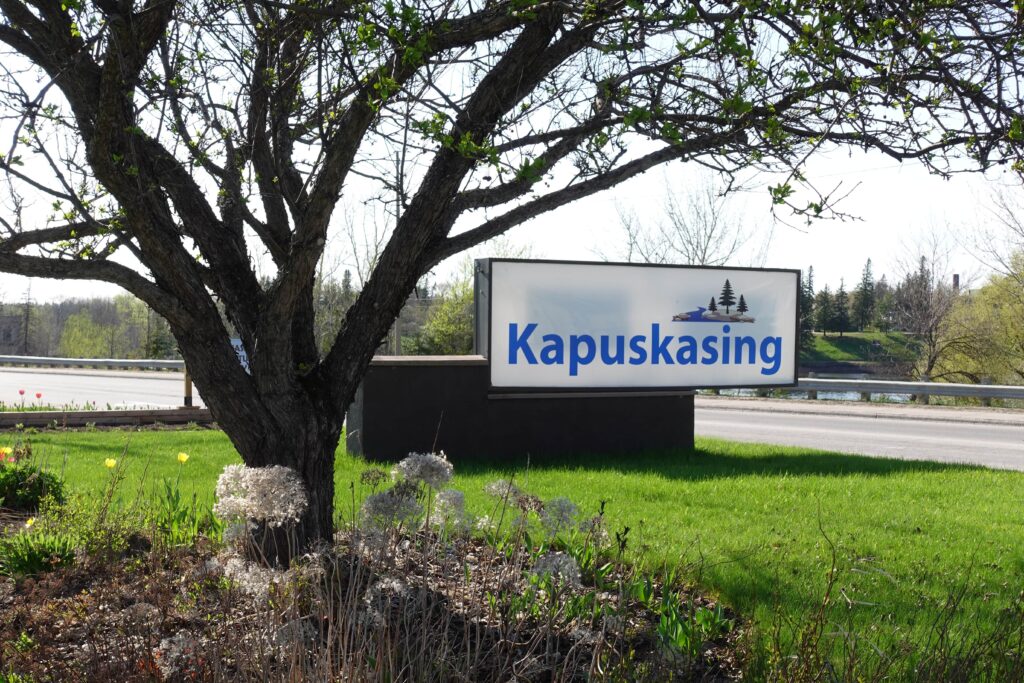
My opinion:
Kap is cool!
A beautiful city, though the papermill at the outskirts is not really a feast for the eyes. The industrial area is separated from the town by the railway line which runs parallel to the Transcanada Highway.
The center of the town is the Circle, a roundabout which has been an important meeting place from the beginning, and where even today one little shop lines up to the next. One of the streets is especially highlighted by an arch with the name Kapuskasing at its top. Meanwhile the usual brands have built their places along the Transcanada Highway, but even at Walmart’s Kapuskasing is celebrated with golden balloons.
Diary:
I’ve got the impression that Kapuskasing is special. People here seem to have a certain self-confidence.
But even before I came here I had an experience that made me come to this conclusion. I spent two nights at a campground in Sutton Bay Park on Lake Timiskaming near New Liskeard. By the way: lovely! Everything perfect, and only one third of the price of a certain terrible campground far out of Kingston which I’ve mentioned before. Not to talk about the friendly welcome and the “Wow”s because I am from Austria. They had never had someone here from Austria.
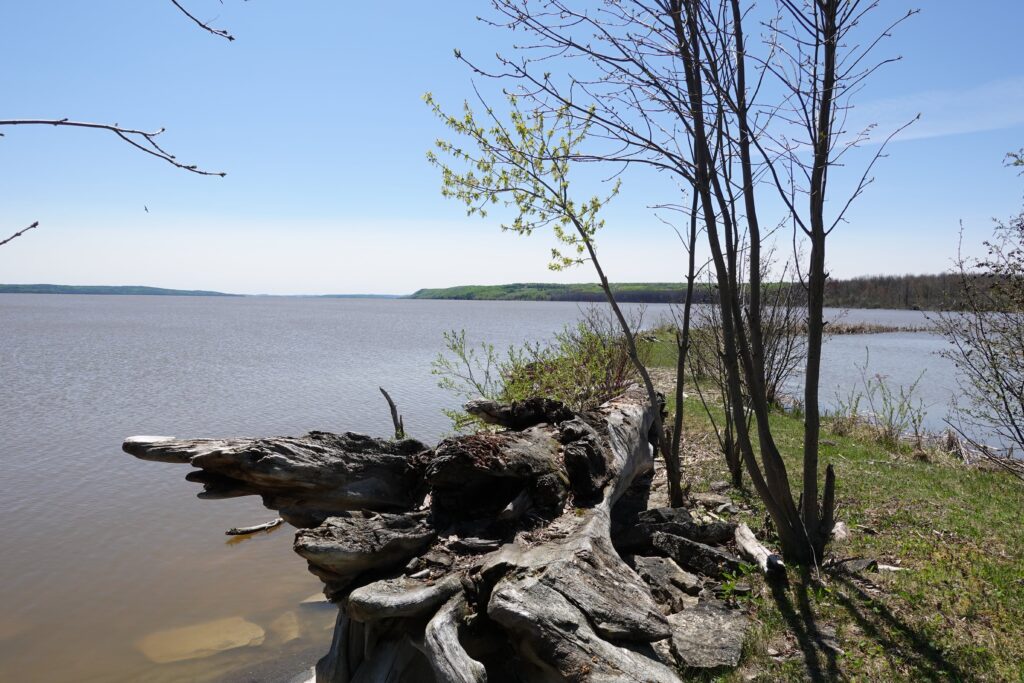

Of course I took a long walk in the area near the campground, then I decided to have a look at the nearby town. Finally I found out that there is a long trail along the shore in New Liskeard.
During my walk there I came to talk to a local. After some sentences – as usual – the question, if I am from Great Britain. (My accent must be terrible.) No, I am from Austria. Why I am here. Then I say a couple of sentences about my father. 1951, Kapuskasing, lumberjack. Kapuskasing? Really? And this question sounded as if it were something special.
And then the man listed all people from Europe who he knew and who had come to Canada in the 1950s. Guess what, all of them had become multi-millionaires, had owned big companies and either passed them on to their kids or sold them, and they had had wonderful lives. – That took me by surprise. My father was about to have his own big company in Hamilton before he went back. About which I am very happy, because this decision finally led to my existence. If my mum had moved to Canada, the probability that they would have had me as their child is close to nothing. That would have been another person. Because my father wouldn’t have worked in India in 1959/60, and when he returned, the joy to see each other again …
Oh yes, when I told the Canadian gentleman at the shore of Lake Timiskaming, that I had taken a walk outside the Sutton Bay Park, he asked me if I had seen bears there.
Me: “Are there bears?”
I have to work on my naivety. Urgently Even more than on my accent.
Yesterday I started into the direction of Kapuskasing. As it was Victoria Day – a holiday – all shops were closed. One of my good intentions had been, as soon as I would leave the highly populated areas, never ever to drive without a full spare can and never with a tank less than half full.
Somehow I had not only ignored that since May 1, I have been in a country with bears and that this country is – apart from some spots – not really densely populated. 38 million people on 10 million km2 (9 million in the area of Toronto – that’s whole Austria). Or, to express it differently: not even 4 people per km2 (I refuse to use decimal places when it comes to human beings.). In Austria there are 107 per km2, which means about 28 times as much. Therefore, Austria would have to have 2.35 million km2 so that each of us could have as much space as someone in Canada. Which means, Canada is sparesly populated. By people. There are 3 bears per 100 km2 on average. That’s enough. Absolutely. They need a lot of space.
The gentlemen from Lake Timiskaming who owns a nice little plot of 200,000 m2 there (which is just unthinkable for someone from tiny little Austria), warned me of moose. There seem to be more fatal car accidents with moose than fatal incidents with bears.
Moose are mainly a danger at night. I don’t drive at night.
So, I had arrived at the north, and there are less than four people per km2. The Transcanada Highway has been built straight through the country whereever the shape of the landscape made that possible. When driving you can see a straight gray line from yourself to the horizon. Building that way makes sense when there is nothing but forest – wonderful, varying forest, but only forest and no settlements for many many kilometers. An occasional advertising poster. Your trusted plumber in the nearest town, only 100 km from here, is Mr. XY. In addition, the Transcanada Highway is not a highway with at least two lanes and one emergency lane in each direction, but it’s a road. And sometimes …
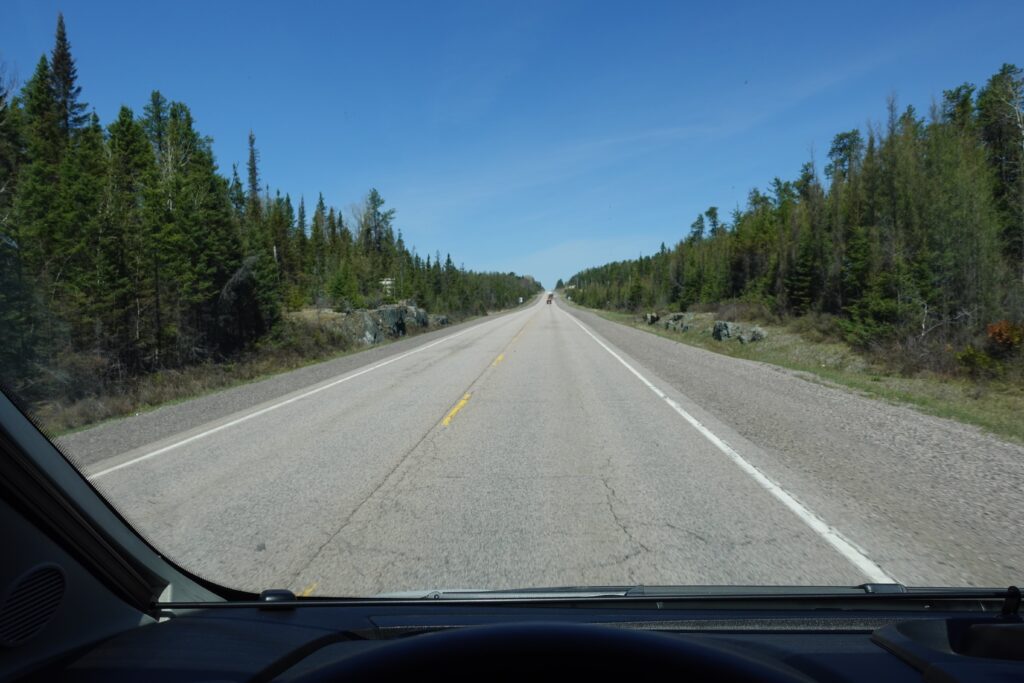
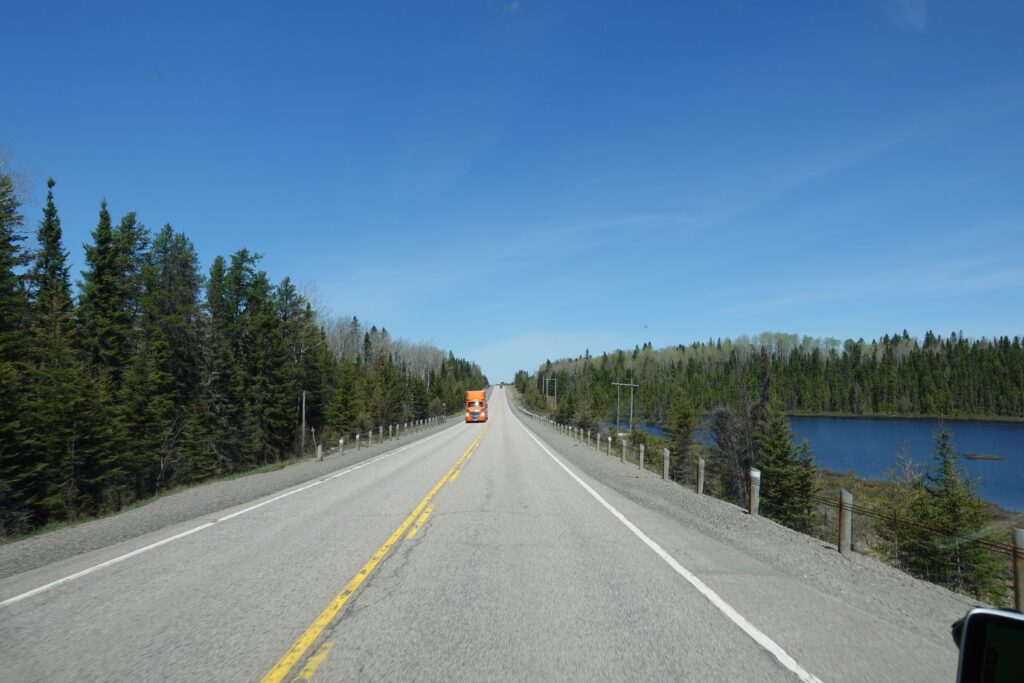
In an area with -40°C (= -40F) in winter, how should they be able to repair all road holes? They can’t even do that in Austria, where they have maybe -5°C.
At the end we found a gas station which was open. On time.
Sometimes there is a road crossing the Transcanada Highway. Then you know, there’s either a lake with lots of fish or there are really some people living somewhere in the forest. Often these roads are not paved. Therefore it’s not a disgrace here to drive a dirty car. No chance to keep it clean. Annie Way has adapted herself cheerfully. Sometimes I clean her windshield at a gas station. There are still insects in North America. Lots of. It makes me feel sad that there a not many left in Europe. We drive with 90 km/h, but we are quicker than the moquitoes.
Driving westwards there is a village named Moonbeam about 20 km before Kapuskasing, and there is a campground, 4 km north of it, in the forest. (Where else?) With its two lakes the place is very idyllic.
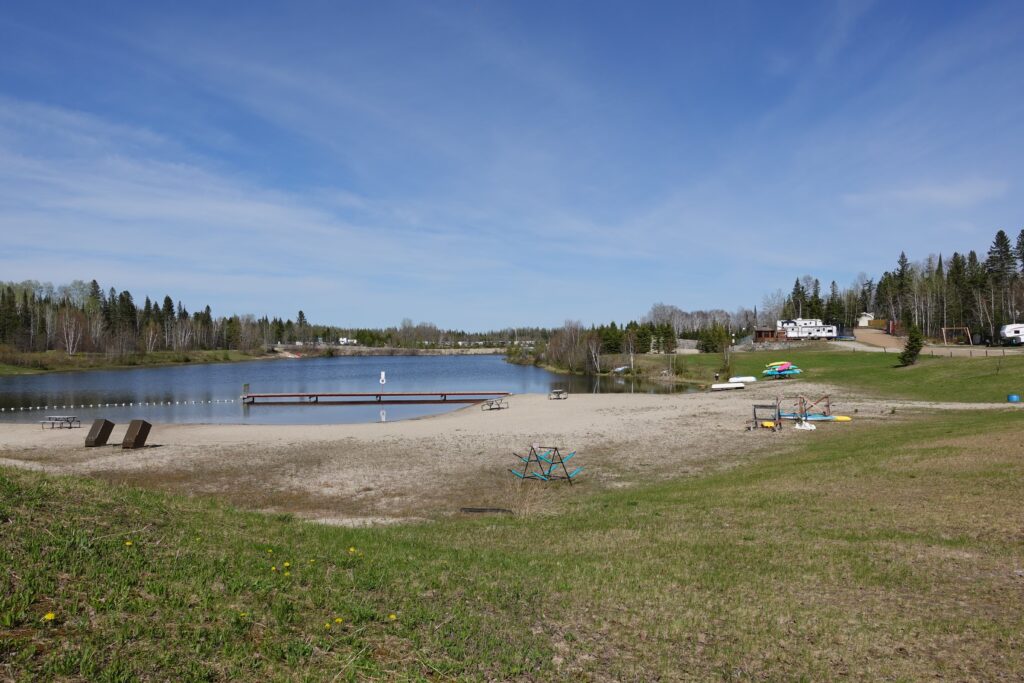
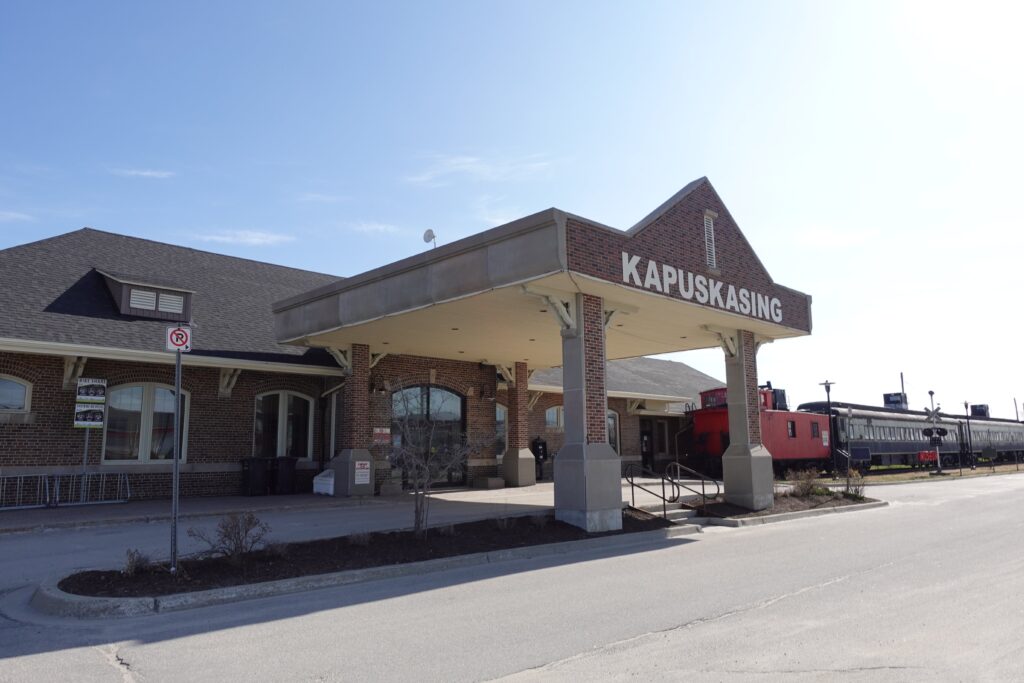
Long ago, when I started thinking about going to Kapuskasing (and beyond), I looked for a place to stay. The name of the campground is Twin Lakes. I decided to go there three years ago.
Now I am here.
In other words: I have made it. Arrived. From now on, everything is just something like an extra benefit. The additional gift.
Kapuskasing. In the footsteps of my father.
After arriving at the campground I enjoyed a late lunch – for some reason or other I never succeed in eating lunch before 3 pm, sometimes later. Maybe it’s because of the delicious cinnemon rolls and the brownies for breakfast, together with a wonderful coffee.
After my late lunch I went arount the two lakes, but didn’t walk into the wood. I haven’t got a bear-spray yet. James und Polly had adviced me urgently to get a bear-spray. But I can’t find any. And no new battery for my wrist-watch.
After my walk I drove to Kapuskasing. 4 km to Moonbeam, and from there 21 km on Transcanada Highway.
The closer you get to Kapuskasing the more traffic there is. Every now and then there are even houses, some of them abandoned.
Speed limit from 90 to 70, a sign telling you that you are now in Kapuskasing, Population: 8,900.
Forest. Then the first houses. Everything on the right side, because on the left there runs the railroad line, behind it: forest. Suburb. Gas station, workshop, small businesses that have their halls here. Single-family homes. Restaurants in between. A motel. The further you go, the more familiar the names become. McDonald’s, Walmart, Esso, Ford, and so on. And always a lot of space in between. Another motel. Not far from the center, which can be recognized by the fact that the speed limit is now 50 and the first traffic lights can be seen in the distance, a golf course. A big one. On the left, a historic station building. Behind it the paper mill. Huge. To the right there is the city center, straight there’s the bridge.
A park along the river. The real center of the city is the Circle, a roundabout. Many tables and chairs in the center. A meeting place. If you want to reach it, you have to cross the street. But what does not matter, there is hardly any traffic. Also, we are in Canada. Consideration and so on. As a pedestrian you can take your time.
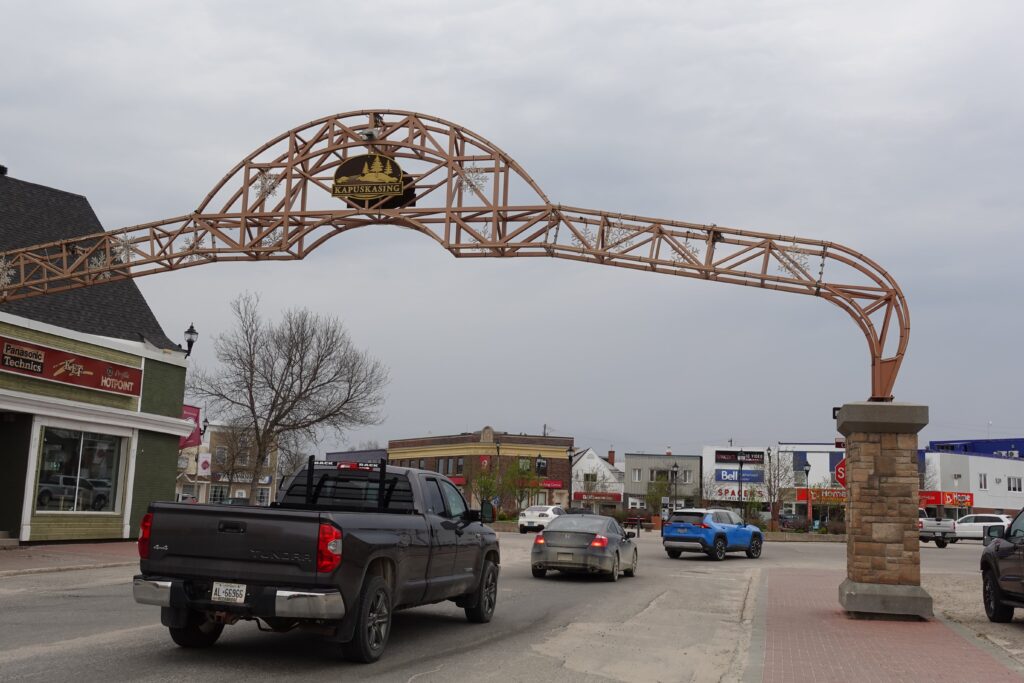
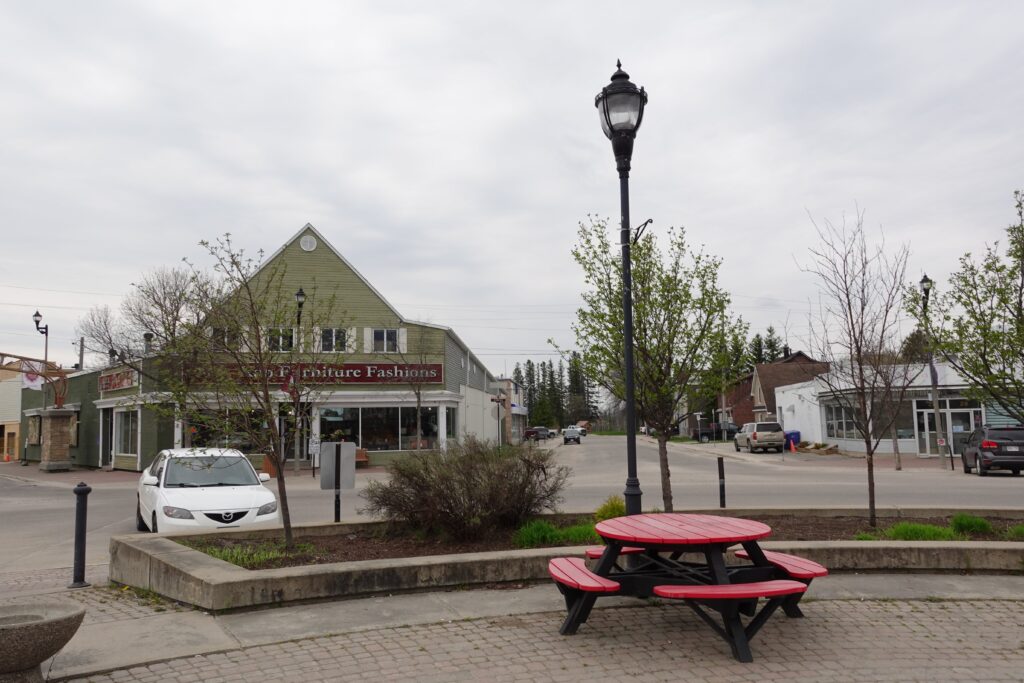
I was standing on the rocks. At the bend of the river. Pointed angle, very abrupt. The river accomplishes this by creating a basin on the outside. It is calm there. Otherwise, the water swirls and foams a bit in the curve.
It is beautiful there. I wonder if my father ever stood on that rock, too.
Kind of disturbing. I’m anything but sentimental by nature.
But here, on the Kapuskasing River, in a town much more beautiful than I had expected, in an area much more beautiful than I had expected, I was standing on a rock and fighting back tears.
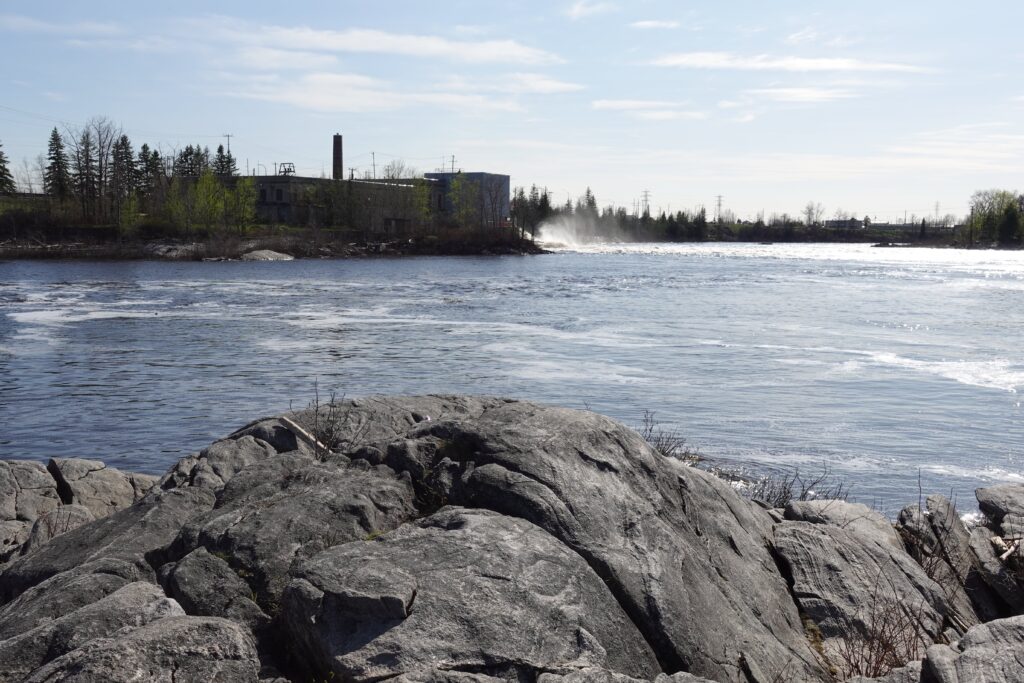
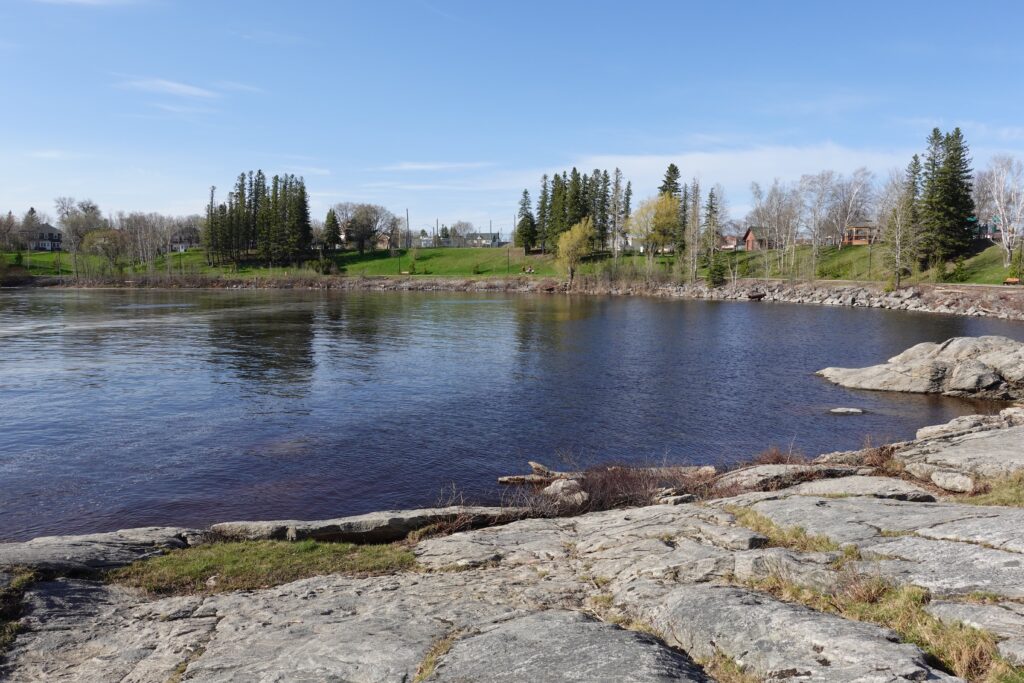
At least I had found the Visitor Center, which was located in the historic station building. If I wanted to find out something about the Lumberjacks 70 years ago, this was the best place to go. But not on Victoria Day. It was closed.
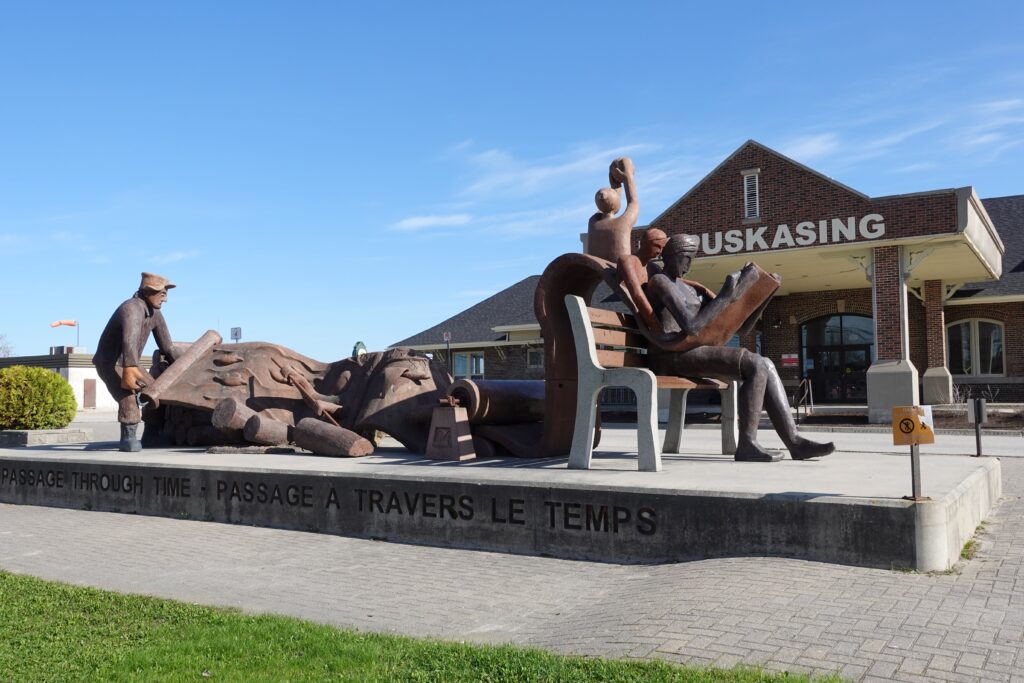
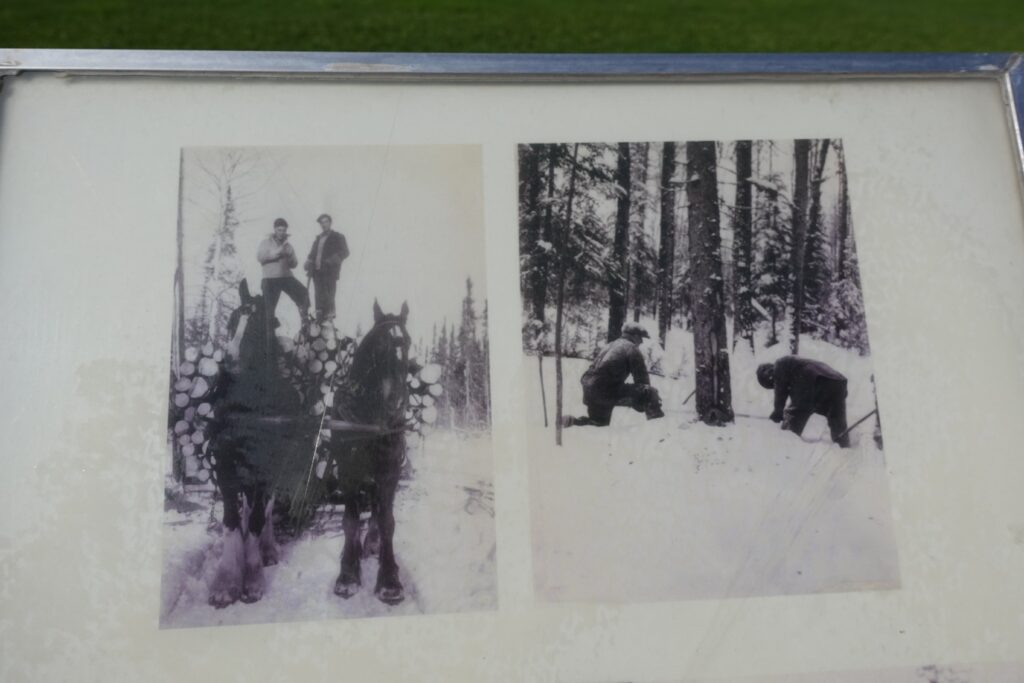
That’s why I went back today.
I entered and was greeted by two young women at the counter with the usual Canadian friendliness. How they could help me?
I come from Austria in Europe, and my father worked here as a lumberjack back in 1951/52.
The two of them were very excited about that. Information brochures, a new one they were working on with pictures of Princess Elizabeth’s visit … I said I had found just such photos in my father’s old photo album, even with the same man holding the car door open …
I don’t know who was more pleased, the two women or me, but one thing was instantly clear: not only are the Lumberjacks of yesteryear not forgotten, they are still highly respected.
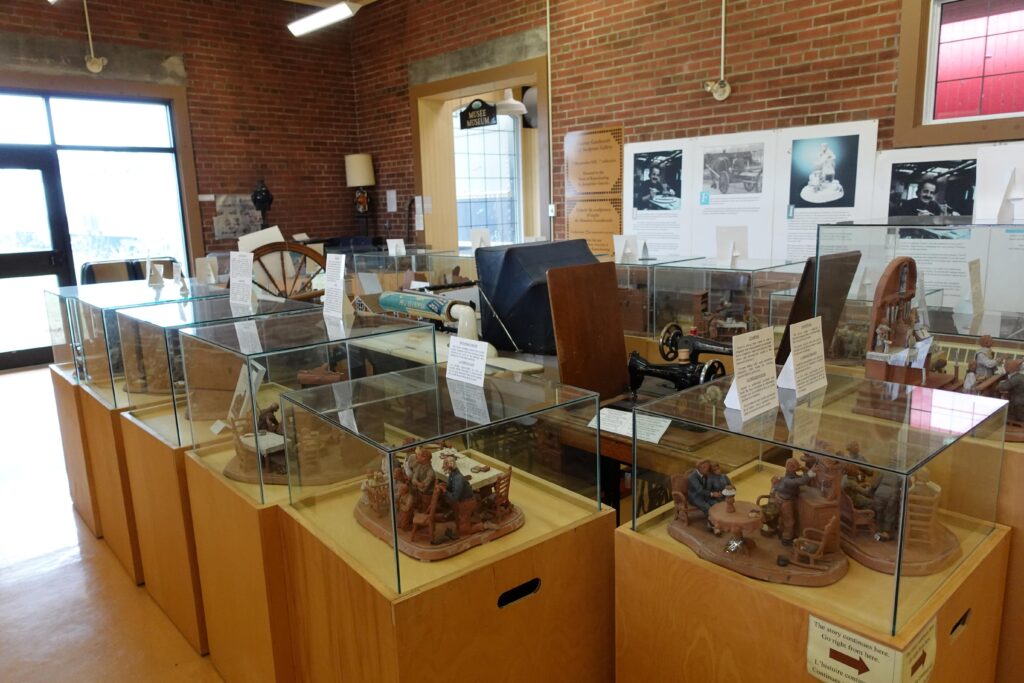
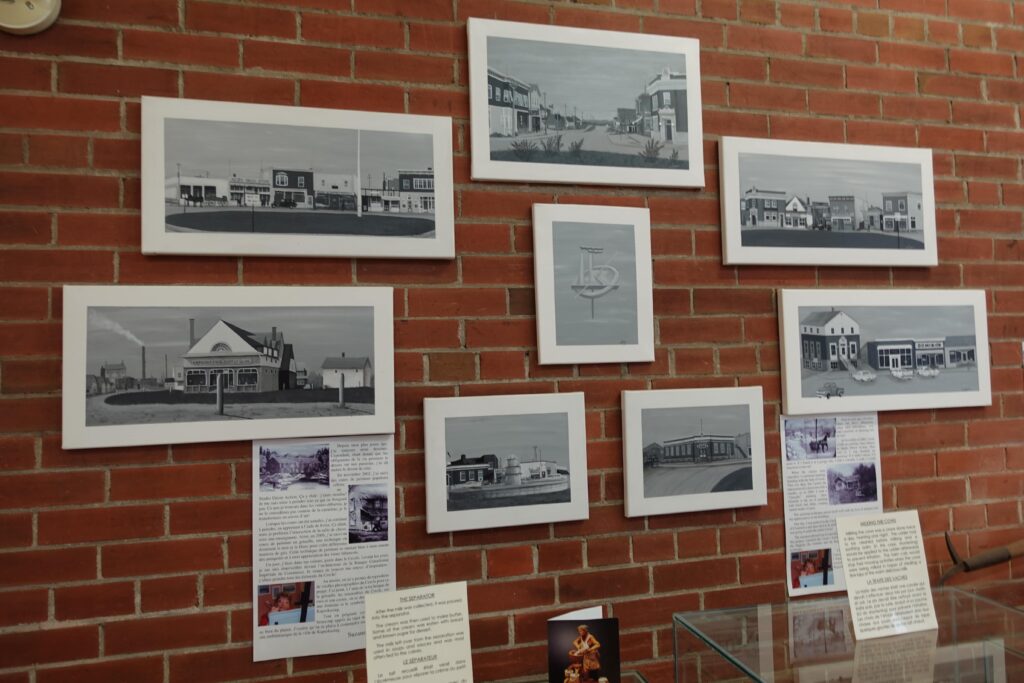
While one lady was still printing things out for me, the other took me to a small museum about the history of Kapuskasing, which is closely linked to the history of the paper mill. Photos of the Lumberjacks’ work, a saw … I suddenly remembered that my father had once mentioned that the saws were two meters long. Here I saw one. The poles used to drive the logs along the river. The horses.
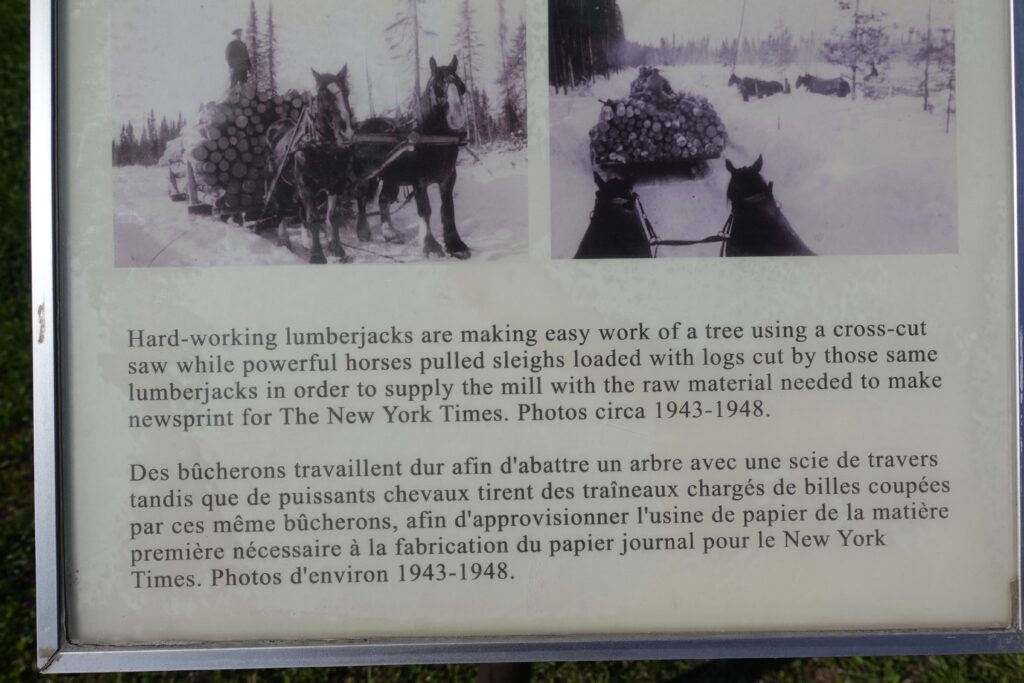
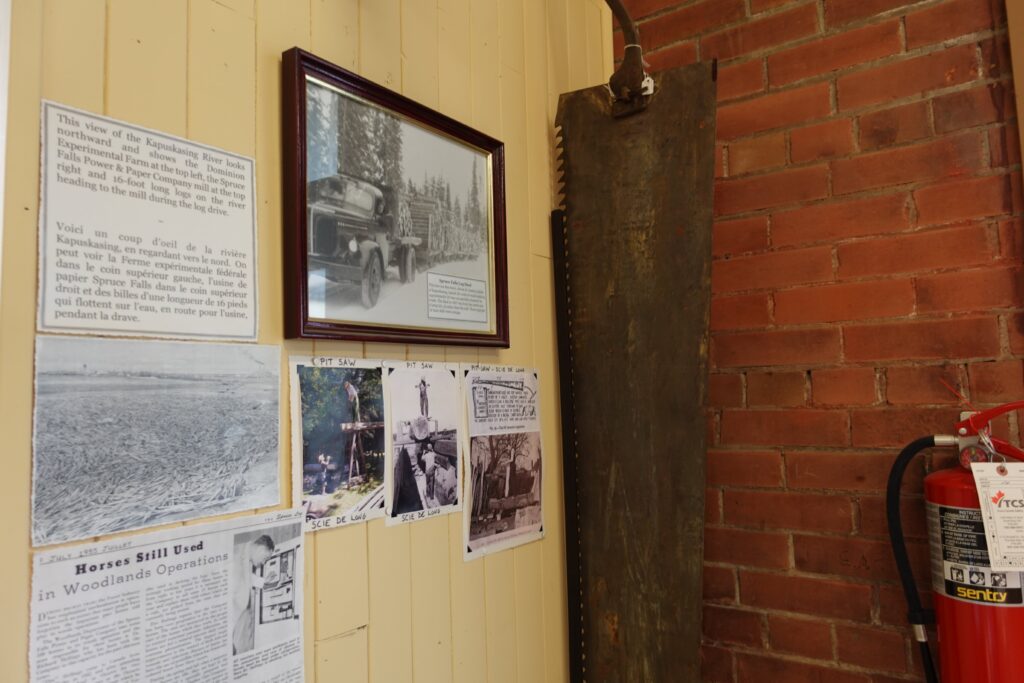
Then I again remembered something.
My father had once told me that they worked with horses in the woods. The animal assigned to him was quite a beast, deliberately doing the opposite of what it was supposed to do. No one wanted it, and he was the new guy. He toiled away with the horse, which made the extremely hard work even harder for him.
Until one day it slipped and landed in a ditch from which it could not get out. All of them tried to free it somehow with pulling and pushing, but nothing helped. Finally it was getting dark, time to head back to camp. A case for the wolves.
My father stayed. He just could not let the animal die alone. With good coaxing, petting and finally a tremendous effort from both of them, they managed to free the horse from the ditch.
From that moment on, he never had a problem again. It did not follow his word, because it was not necessary to say anything at all. The horse knew in advance what he wanted and what it had to do. Until he left Kapuskasing, the animal never left his side and did everything to make his work easier and to make him laugh with an occasional nudge.
And there was something else I remembered in the small museum. My father had once said that -40°C in dry cold is less bad than -5°C in damp cold in our country. I hadn’t thought about it at the time, but he had probably had the -40°C experience in Kapuskasing. Last year I kept checking the temperatures in various places in Canada, and the number of days it was actually -40°C in Kapuskasing startled me. At first I thought that the Lumberjacks didn’t work on such cold days, but then I remembered this comment he made. They worked. In any weather and temperature.
There was one scene in the museum that I thought was cute: there they were sitting together in the evening, and one of them was telling stories.
I also remember my father saying that they used to cut a path about 100 meters wide into the forest, and then they would move on for a few kilometers. It was not necessary to take care of reforestation, the forest took care of that on its own within a very short time.
Now that I’ve got a sense of the density and wildness of these forests, I understand. They are impenetrable. That is something quite different from forests in Austria, where you can cut out individual trees.
Here in the north, the black spruce predominates, there are some pines, lots of birches and alders, surprisingly also the larches, which I have not seen further south.
Back to the small museum. I took a lot of time to look at everything. An artist had created scenes from the life of that time as ceramic figures, so it seems a bit like a miniaturized world, complemented by original objects. In addition there’s information and photos.
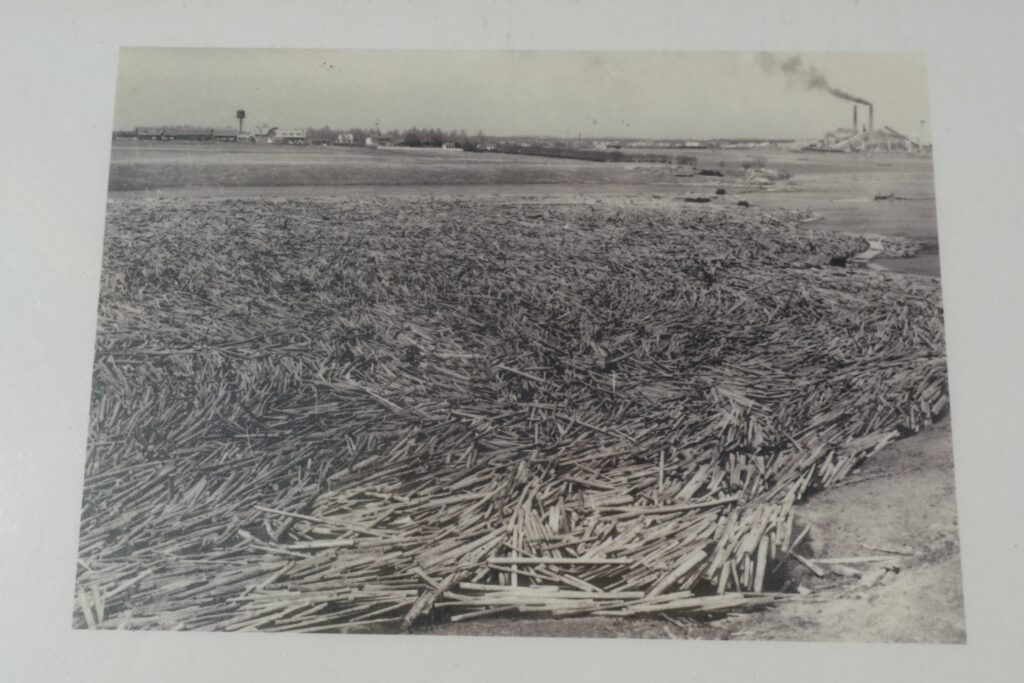
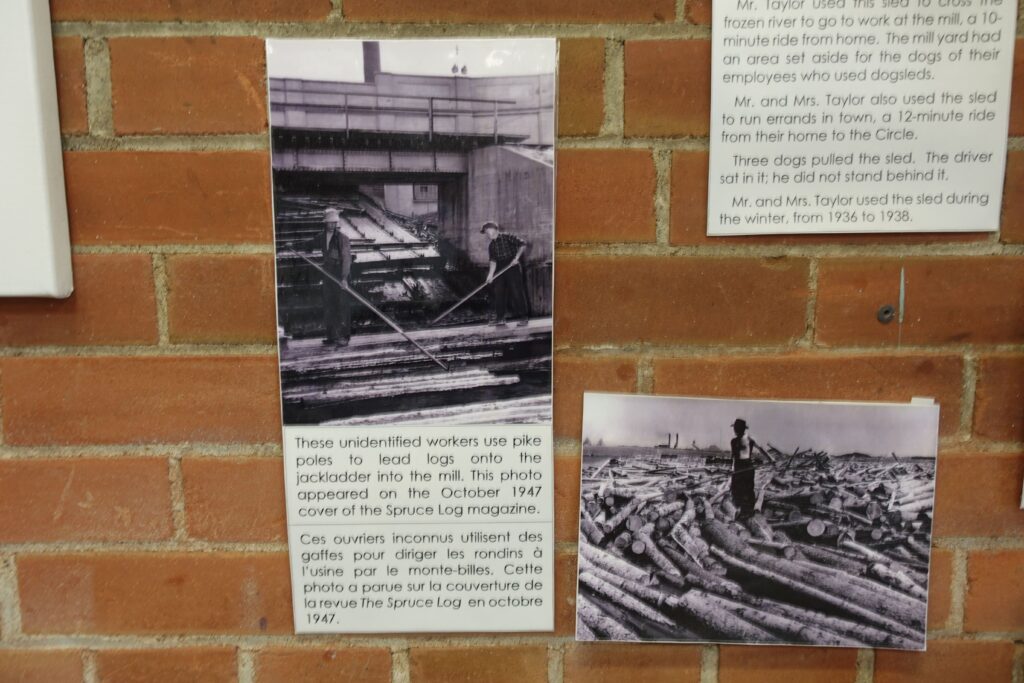
Back at the Visitor Center the other lady had printed out some things for me in the meantime. I also got a Kapuskasing folder for the printouts, a Kapuskasing pin, a Kapuskasing coaster set, and because they were so happy I was there and I knew I would be upset afterwards, if I didn’t, and because I would never come here again, I took a purple Kapuskasing T-shirt and a gray Kapuskasing hoody, put a friendly bill in the donation box, and, at their request, wrote something else on the Kapuskasing guest sheet, which I usually never do. I left the Kapuskasing Visitor Center with a Kapuskasing bag full of treasures.
Shortly afterwards, despite the now pouring rain, I stood again on a rock by the river at the bend that gave the town its name, and this time I cried.
They have not been forgotten, the Lumberjacks who worked in the woods in those days, as my father did. They are legendary. And people know what they have to thank them for.
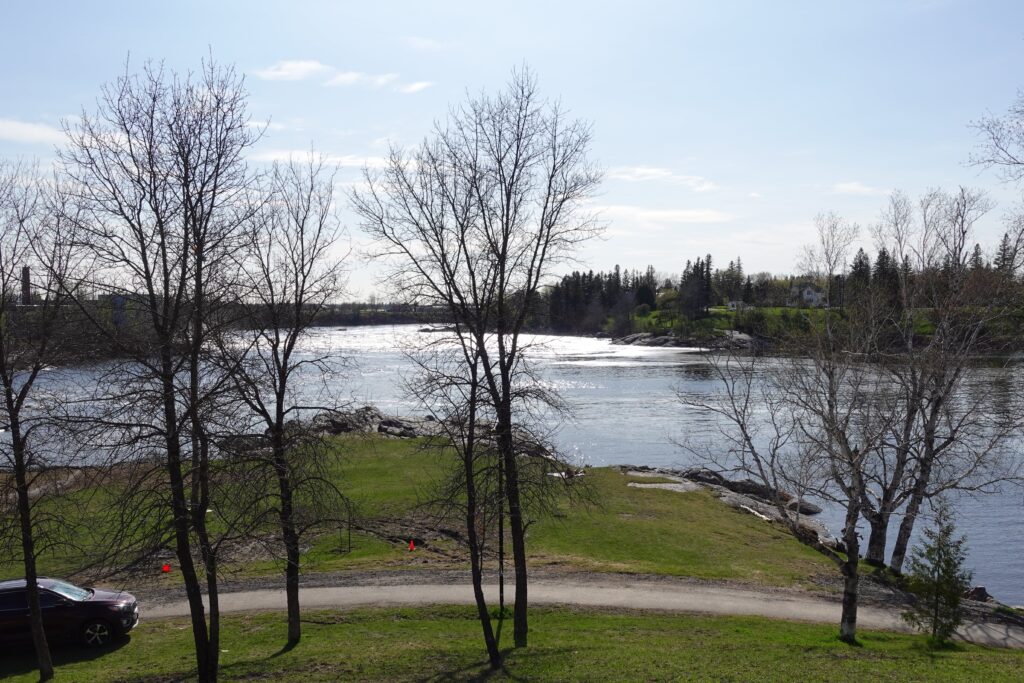
Photos courtesy of the Visitor Center of Kapuskasing.
